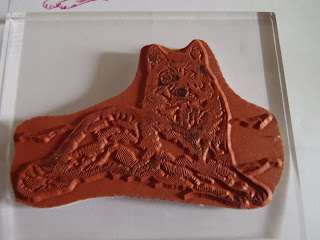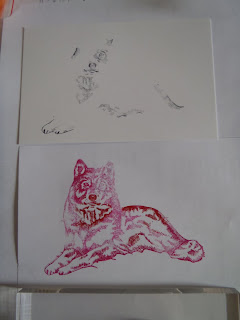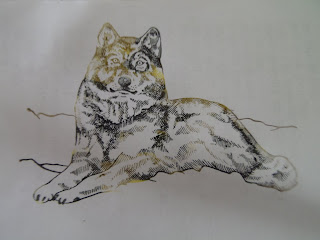 Here's what my stamp looked like when I was done trying to do my first picture. You can still see the black marker around one eye and the nose. That's all that made the glossy paper (see the stamp below).
Here's what my stamp looked like when I was done trying to do my first picture. You can still see the black marker around one eye and the nose. That's all that made the glossy paper (see the stamp below).So I did an experiment. I used the same stamp and tried it with my water based markers (the pink/red wolf). Much better, but not quite what I want in a wolf.
So I tried a third attempt. I used some cheap dollar store markers, the yellow, orange, brown and black (you always want to go light to dark or you'll ruin your markers). Not bad, but not quite card quality either. I'll have to invest in another set of water based markers, with earth tones (rather than the colour set I got, which should be great for birds, butterflies and flowers). I still noticed that the lighter colours had faded by the time I stamped the card. Maybe that's why the demonstrator emphasized that you don't have to look at what you're doing when you colour. You colour faster that way and end up with more ink still on the stamps when you stamp your page.
Compare that with the results of the rose stamp I got at the Stampin' Up booth. I used pigment dyes I bought as a 4 set (2 reds, green and gold) at another booth (I don't remember which booth this was, though I suspect it was either Art Tales or Memory Keeper. I bought a bunch of stuff there, including the Vanilla Smooch Spritz used to give the finished card a sparkly sheen).
My rose set is designed to have each picture stamped twice, once for the base, and again for the highlights. It was quick and easy and worked perfectly both times (though with the stamps having wood backing you have to watch your placing carefully or they won't line up). I did the main rose twice, then layered it over the sparkly background.
I'm hoping with practice I'll get better with the marker stamps. When done well they look fantastic.A few hours after doing this post (set to publish the following day), I decided to do a search for the marker tip sheet the woman at Stampin' Up said she'd send me if I emailed. I was correct in thinking the search would be easier. And I found it. It's a pdf file you can download here. (Or you can do a search for "Stampin Up marker tip sheet", it's the fifth result). The first result, Using Markers - Stampin' Up is the one that taught me the best tip though:
3. Breathe on the inked image to remoisten the ink before stamping onto paper.
Such an easy trick! And it works. So you don't have to colour fast to get good inked images. Just breathe on the stamp to make the ink wet again. I tried a few of my stamps to practice. Here are the results. Much better. Now I just need black, grey and earth tone water based markers and I'm in business. :)









